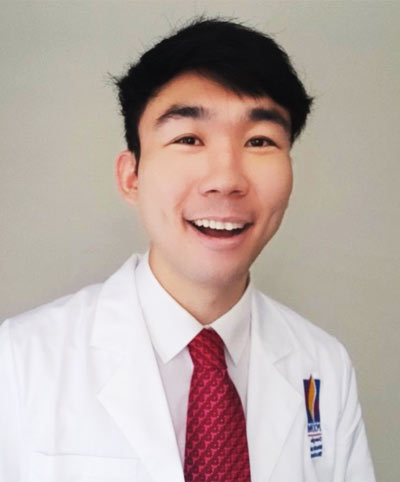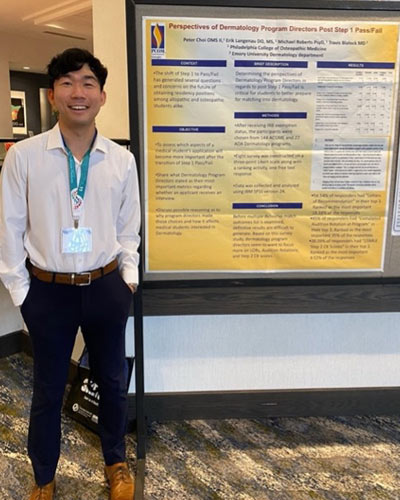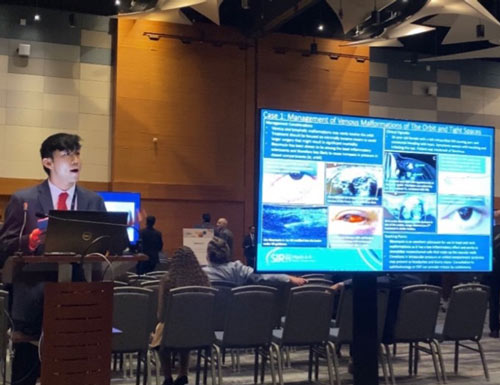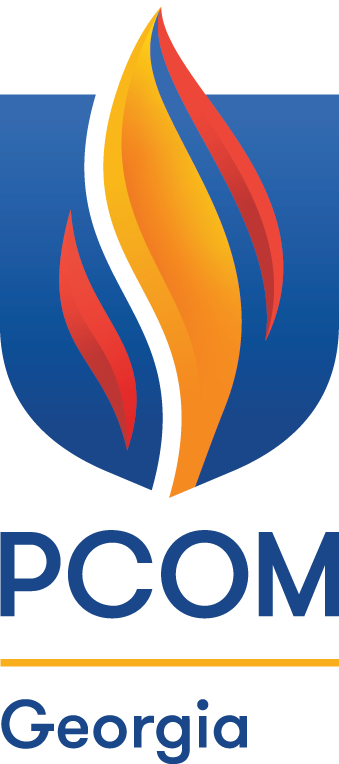Treating Vascular Malformations
Peter Choi (DO ’24)
March 31, 2023Growing up in North Wales, Pennsylvania, Peter Choi (DO ’24) initially wanted to attend
culinary school to become a chef. Even while he was an undergraduate student at Lehigh
University majoring in psychology, the thought of studying medicine seemed like learning a whole new language. Choi didn’t have any mentors, life-altering
personal stories, or family members in medicine that would give him easy access to
a healthcare career. He didn’t know where to start and said he felt like the new kid
at school holding a lunch tray and not knowing where to sit.
He recalls that switching from learning about Sigmund Freud at Lehigh to ideal gas
laws for the MCAT was an adventure. “Fast forward to now as a third year medical student,
and I realize I was very fortunate to obtain those mentors and personal experiences
throughout my time at PCOM Georgia. Not only am I now applying medicine in clinical rotations, but I am also part of the evidence-based research process that drives how medicine
is practiced,” he said.
“I didn’t become a chef in the end, but I still was able to create something amazing
that I can be proud of.”
He said, “Research can be perceived as this mysterious, invisible entity that is only
reserved for a select few and the elite. This cannot be further from the truth. I
challenge students to seek out people who are willing to take a chance on them. If
finding someone is not realistic, create your own project. Start your own timeline
and become the person that other students come to.”
In lay terms, what are you studying?
The International Society for the Study of Vascular Anomalies (ISSVA) classifies low-flow
vascular malformations as lymphatic and venous malformations, many of which occur
in the head and neck. Clinical diagnosis of these vascular lesions is aided by several
imaging modalities such as US and MRI which provide findings that are characteristic
of each vascular malformation. Following diagnosis, interventional radiologists and
otolaryngologists may offer several treatment options in tandem or together aimed
at reducing the progression of and preventing further complications of low-flow malformations.
I am studying treatment strategies that best detail the collaborative work between
ENT and IR including indications for several sclerosants (STS embolic foam, bleomycin,
and doxycycline) and novel therapeutics (Sirolimus and Alpelisib), and how these treatments
can be used in conjunction with otolaryngology. Special attention is given to indications
to appropriate treatment, diagnostic and treatment pitfalls, technical considerations,
and clinical follow-up.
What prompted you to pursue research?
To be transparent, I initially wanted to pursue research because I wanted to check
off a box for my resume. I naively thought that’s just what all students did but didn’t
want to admit. However, I decided to stay in the game and continue research on my
own free accord because I have grown to enjoy the process of generating an idea, delineating
a plan, handpicking my own team, executing goals, learning the language of statistics
as well as intensely working with colleagues and attendings that ultimately deepen
and add a new dimension to the professional relationship. Everyone says that having
a mentor is key to doing research. The word mentor however is vague and doesn’t specifically
delineate their role in relation to the student. I believe a more accurate description
is to find someone who will take a chance on you. Research projects are an investment
in time and finding a PI who is willing to take a chance on you is the reason why
I have continued to pursue and be fulfilled in my research projects.
What experience do you have conducting research?
I first started working in the Public Health and Psychology departments at Lehigh
University where I analyzed adolescent alcohol usage literature, coded data categorizing
specific protective behavior strategies, as well as beta tested peer health initiatives
that focused on plans to reduce harmful adolescent behavior. During my first year
at PCOM Georgia, I decided to challenge myself and completely start my own project
from scratch. The most important aspect of research is to consider whether it’s a
niche topic, meaning the topic should offer new information that has limited literature
and data. For example, the USMLE Step 1 had gone Pass/Fail and my class of 2024 will
be the first to undergo Match Day with Pass/Fail scores. I wanted to know how this will influence dermatology program
directors in whom they choose to interview and what parts of the application they
will focus on since previously, Step 1 scores were an important screening metric.
My current project involves exploring the effects of different diagnostic and treatment
modalities that encourage interdisciplinary involvement from otolaryngologists and
interventional radiologists in treating vascular low flow malformations of the head
and neck. As first author for both of these projects, I had to familiarize myself
with every aspect of the process from the initial idea, to final publication.
What were your responsibilities in the research project?
My responsibilities started with the initial literature review of the topic at hand.
I had to make sure that I had all my ducks in a row and ensure that my topic was a
new area of research that is meaningful, and had not been done before. Afterwards,
I had to create my team of people who made sense to be part of the project, as well
as attendings who wanted to take a chance on me. Drafting the proposal as well as
obtaining IRB approval was the next priority. Becoming familiar with the software
that collected data was my next goal. After the data was collected, I sought out the
help of a statistician to help me analyze the data. After interpreting our results,
the next step was drafting the full manuscript. I then created my poster with the
help of PCOM and submitted my project to the American Association of Colleges of Osteopathic
Medicine Emerging Leaders Conference where I was the primary presenter. The next step
was finding the appropriate journal to submit to. After being deferred four times
and having to hire multiple professional editors and constant revisions on my end,
my article was finally published.
What is the broader impact of your research?
The broader impact of my research is that vascular malformations of the head and neck
can involve certain high-risk areas such as the orbit and tongue. Many specialists
are hesitant to treat around this area and opting to not recommend treatment is common.
The use of certain sclerosants such as bleomycin, for example, has recently been used
to embolize these vascular malformations due to their strong mesenchymal destabilization
properties and low inflammatory profile. The study has shown that the patients with
these malformations in the eye for example, have been successfully treated with bleomycin
with complete resolution of symptoms. In patients with more advanced lesions, a combination
of sclerosant use from interventional radiology and laser debulking surgery from otolaryngology
can be utilized to maximize efficacy and minimize adverse events.
About PCOM Georgia
PCOM Georgia has been serving students and the community for 20 years as a branch campus of Philadelphia
College of Osteopathic Medicine (PCOM), a private, not-for-profit, accredited institution
of higher education established in 1899. Located in Suwanee (Gwinnett County), PCOM
Georgia offers doctoral degrees in osteopathic medicine, pharmacy and physical therapy.
Graduate degrees are offered in biomedical sciences, medical laboratory science and
physician assistant studies. The campus joins PCOM South Georgia in Moultrie in helping
to meet the healthcare needs of the state. Emphasizing "a whole person" approach to
care, PCOM Georgia focuses on educational excellence, interprofessional education
and service to the community. For more information, visit pcom.edu or call 678-225-7500. The campus is also home to the Georgia Osteopathic Care Center,
an osteopathic manipulative medicine clinic, which is open to the public by appointment.
For more information, visit pcomgeorgiahealth.org.
Contact Us
For general media inquiries, please contact the Office of Marketing and Communications
at 215-871-6300 or communications@pcom.edu. Visit our media relations page to view contact information for public relations personnel.
Connect with PCOM Georgia

 Growing up in North Wales, Pennsylvania, Peter Choi (DO ’24) initially wanted to attend
culinary school to become a chef. Even while he was an undergraduate student at Lehigh
University majoring in psychology, the thought of
Growing up in North Wales, Pennsylvania, Peter Choi (DO ’24) initially wanted to attend
culinary school to become a chef. Even while he was an undergraduate student at Lehigh
University majoring in psychology, the thought of  The International Society for the Study of Vascular Anomalies (ISSVA) classifies low-flow
vascular malformations as lymphatic and venous malformations, many of which occur
in the head and neck. Clinical diagnosis of these vascular lesions is aided by several
imaging modalities such as US and MRI which provide findings that are characteristic
of each vascular malformation. Following diagnosis, interventional radiologists and
otolaryngologists may offer several treatment options in tandem or together aimed
at reducing the progression of and preventing further complications of low-flow malformations.
I am studying treatment strategies that best detail the collaborative work between
ENT and IR including indications for several sclerosants (STS embolic foam, bleomycin,
and doxycycline) and novel therapeutics (Sirolimus and Alpelisib), and how these treatments
can be used in conjunction with otolaryngology. Special attention is given to indications
to appropriate treatment, diagnostic and treatment pitfalls, technical considerations,
and clinical follow-up.
The International Society for the Study of Vascular Anomalies (ISSVA) classifies low-flow
vascular malformations as lymphatic and venous malformations, many of which occur
in the head and neck. Clinical diagnosis of these vascular lesions is aided by several
imaging modalities such as US and MRI which provide findings that are characteristic
of each vascular malformation. Following diagnosis, interventional radiologists and
otolaryngologists may offer several treatment options in tandem or together aimed
at reducing the progression of and preventing further complications of low-flow malformations.
I am studying treatment strategies that best detail the collaborative work between
ENT and IR including indications for several sclerosants (STS embolic foam, bleomycin,
and doxycycline) and novel therapeutics (Sirolimus and Alpelisib), and how these treatments
can be used in conjunction with otolaryngology. Special attention is given to indications
to appropriate treatment, diagnostic and treatment pitfalls, technical considerations,
and clinical follow-up. My responsibilities started with the initial literature review of the topic at hand.
I had to make sure that I had all my ducks in a row and ensure that my topic was a
new area of research that is meaningful, and had not been done before. Afterwards,
I had to create my team of people who made sense to be part of the project, as well
as attendings who wanted to take a chance on me. Drafting the proposal as well as
obtaining IRB approval was the next priority. Becoming familiar with the software
that collected data was my next goal. After the data was collected, I sought out the
help of a statistician to help me analyze the data. After interpreting our results,
the next step was drafting the full manuscript. I then created my poster with the
help of PCOM and submitted my project to the American Association of Colleges of Osteopathic
Medicine Emerging Leaders Conference where I was the primary presenter. The next step
was finding the appropriate journal to submit to. After being deferred four times
and having to hire multiple professional editors and constant revisions on my end,
my article was finally published.
My responsibilities started with the initial literature review of the topic at hand.
I had to make sure that I had all my ducks in a row and ensure that my topic was a
new area of research that is meaningful, and had not been done before. Afterwards,
I had to create my team of people who made sense to be part of the project, as well
as attendings who wanted to take a chance on me. Drafting the proposal as well as
obtaining IRB approval was the next priority. Becoming familiar with the software
that collected data was my next goal. After the data was collected, I sought out the
help of a statistician to help me analyze the data. After interpreting our results,
the next step was drafting the full manuscript. I then created my poster with the
help of PCOM and submitted my project to the American Association of Colleges of Osteopathic
Medicine Emerging Leaders Conference where I was the primary presenter. The next step
was finding the appropriate journal to submit to. After being deferred four times
and having to hire multiple professional editors and constant revisions on my end,
my article was finally published.